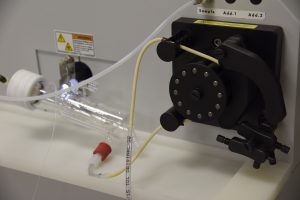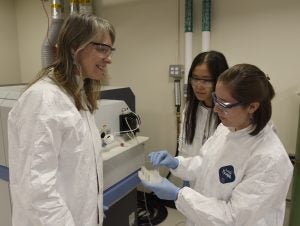MEAL provides solution-based elemental analysis on a variety of materials from rock through to natural waters in concentration ranges from ppm to ppt in biological, environmental, geological and industrial materials.
With rapid and cheap analysis in mind, the Thermo Scientific ICAP quadrupole ICP-MS (Q ICP MS) will handle basic elemental analysis on a variety of material in solution including waters, carbonates, whole rock, and sediments. This mass spectrometer uses an electrostatic filter that only allows ions of a single mass-to-charge ratio pass to the detector by switching voltages on four rods (the quadrupole). This voltage switching occurs so rapidly, however, that analysis of different mass-to-charge ratios is effectively instantaneous. The new system is designed to provide high throughput analysis on a range of cations from Lithium to ~Rubidium and will become the lab workhorse. The simplicity of this instrument means that students will have an opportunity to run their own elemental samples with only a small amount of training.
The lab has cutting-edge analytical ability through the Thermo Scientific Element 2 high-resolution ICP-MS (HR ICP-MS) designed to provide rare earth element concentrations, high precision isotopic ratio analysis as well as measuring elements found in very low concentrations. This higher resolution instrument uses a magnet to separate the different elements by mass-to-charge reducing interference due to mass overlap.
Solutions are introduced to the ICP-MS via peripheral instruments – the ‘front end’. The front end of the ICP-MS varies depending on the application – currently, the applications are solution-based. The most basic front end is an autosampler (e.g. the SC-2 DX) with an automated arm that sequentially samples from a tray. The autosamplers will be housed in ULPA filtered vented polypropylene enclosures. Solutions are introduced to the ICAP Q ICP-MS through a fully integrated auto-calibration and intelligent auto-dilution system (prepFAST2). This autosampler is suitable for a workhorse instrument that will perform routine sample analysis. It auto-calibrates the instrument from a single stock solution, dilutes samples inline (so high concentration elements can be analyzed alongside low concentration). This removes tedious sample prep and dilution steps usually performed manually in a fume hood making the analysis and lab manager more time efficient.
In addition to autosamplers, other peripherals are available. A desolvation system (such as the Apex 2Q ) is needed to remove oxides, hydrides etc that may form when oxygen or hydrogen derived from water or other solvents combine with species present in the sample. The seaFASTS2 system can be operated as a standalone system or connected directly to an instrument (HR or Q ICP-MS). This system purifies a suite of transition row elements and lanthanides from group one elements. Preconcentration combined with matrix removal provide excellent detection limits. Although traditionally used for seawater this instrument can be adapted to also run freshwater, pore water, brines, carbonates and rocks. As the U-Th-U method uses radioactive materials and because U and Th are most stable in dilute HF, a dedicated front end for this analysis is required. The APEX-Omega HF desolvating unit uses an HF-resistant sample introduction kit, including a PFA-ST Nebulizer, PFA spray chamber, 1.8 mm sapphire injector, platinum shield disc, and quartz torch
With access to Class 1000 clean lab facilities and with the bulk of the samples being analyzed on the Q-ICP-MS, contamination issues will be minimal.


